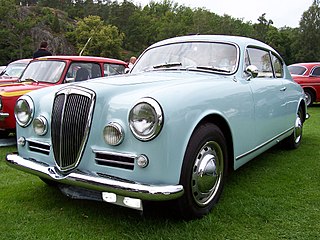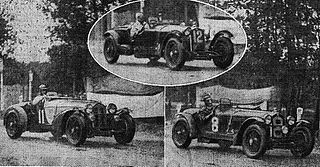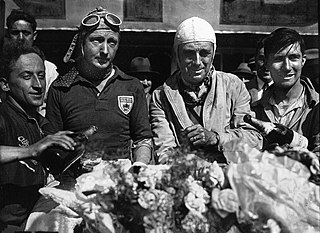
Tazio Giorgio Nuvolari was an Italian racing driver. He first raced motorcycles and then concentrated on sports cars and single-seaters. A resident of Mantua, he was known as 'Il Mantovano Volante' and nicknamed 'Nivola'. His victories—72 major races, 150 in all—included 24 Grands Prix, five Coppa Cianos, two Mille Miglias, two Targa Florios, two RAC Tourist Trophies, a Le Mans 24-hour race, and a European Championship in Grand Prix racing. Ferdinand Porsche called him "the greatest driver of the past, the present, and the future."

Raymond Sommer was a French motor racing driver. He raced both before and after WWII with some success, particularly in endurance racing. He won the 24 Hours of Le Mans endurance race in both 1932 and 1933, and although he did not reach the finishing line in any subsequent appearance at the Le Mans, he did lead each event until 1938. Sommer was also competitive at the highest level in Grand Prix motor racing, but did not win a race. He won the French Grand Prix in 1936, but the event that year was run as a sports car race. After racing resumed in the late 1940s, Sommer again won a number of sports car and minor Grand Prix events, and finished in fourth place in the 1950 Monaco Grand Prix, the second round of the newly-instituted Formula One World Drivers' Championship. He was killed toward the end of 1950, when his car overturned during a race at the Circuit de Cadours.

The French Grand Prix, formerly known as the Grand Prix de l'ACF, is an auto race held as part of the Fédération Internationale de l'Automobile's annual Formula One World Championship. It is one of the oldest motor races in the world as well as the first "Grand Prix". It ceased shortly after its centenary in 2008 with 86 races having been held, due to unfavourable financial circumstances and venues. The race returned to the Formula One calendar in 2018 with Circuit Paul Ricard hosting the race.

Jean-Pierre Wimille was a Grand Prix motor racing driver and a member of the French Resistance during World War II.

Otto Wilhelm Rudolf Caracciola was a racing driver from Remagen, Germany. He won the European Drivers' Championship, the pre-1950 equivalent of the modern Formula One World Championship, an unsurpassed three times. He also won the European Hillclimbing Championship three times – twice in sports cars, and once in Grand Prix cars. Caracciola raced for Mercedes-Benz during their original dominating Silver Arrows period, named after the silver colour of the cars, and set speed records for the firm. He was affectionately dubbed Caratsch by the German public, and was known by the title of Regenmeister, or "Rainmaster", for his prowess in wet conditions.

A grand tourer (GT) is a type of sports car that is designed for high speed and long-distance driving, due to a combination of performance and luxury attributes. The most common format is a front-engine, rear-wheel-drive two-door coupé with either a two-seat or a 2+2 arrangement. Grand tourers are most often the coupé derivative of luxury saloons.

The 1951 Formula One season was the fifth season of FIA Formula One motor racing. It featured the 1951 World Championship of Drivers, which commenced on 27 May 1951 and ended on 28 October after eight races. The season also included 14 races that were open to Formula One cars but did not count towards the championship standings.

Vittorio Brambilla was a Formula One driver from Italy who raced for the March, Surtees and Alfa Romeo teams. Particularly adept at driving in wet conditions, his nickname was "The Monza Gorilla", due to his often overly aggressive driving style and sense of machismo. He was particularly known for his 'Punch and Crunch' routine, in which, he would greet the unfortunate victim with an extremely strong handshake. He enjoyed watching the recipient wince whilst they were shaking hands only to follow this up with a rabbit punch to the back of one's neck.

Giuseppe Campari was an Italian opera singer and Grand Prix motor racing driver.

The 1933 24 Hours of Le Mans was the 11th Grand Prix of Endurance. It took place at the Circuit de la Sarthe on 17 and 18 June 1933. Up against five strong privateer entries from Alfa Romeo, the opposition looked fairly weak, mostly being of 1920s vintage. There was a strong British contingent in the smaller classes. The big drawcard was the presence of top European drivers Louis Chiron and Tazio Nuvolari. The current European champion was paired with one of the previous year’s winners, Raymond Sommer
The 1932 24 Hours of Le Mans was the 10th Grand Prix of Endurance that took place at the Circuit de la Sarthe on 18 and 19 June 1932. A significant year for the Automobile Club de l'Ouest (ACO) with the biggest changes to the circuit in the race's history. A new section bypassing Pontlieue suburb was built starting with a long right turn after the pits, going over a hill then down to the Esses, a left-right combination, before rejoining the Hunaudières straight at the new right-hand corner of Tertre Rouge. This shortened the track by almost 3 km down to 13.491 km (8.383 mi).

The 1931 24 Hours of Le Mans was the 9th Grand Prix of Endurance that took place at the Circuit de la Sarthe on 13 and 14 June 1931.
The 1930 24 Hours of Le Mans was the 8th Grand Prix of Endurance that took place at the Circuit de la Sarthe on 21 and 22 June 1930. It saw the first appearance of a German car and the first entry from female drivers.

The 1929 24 Hours of Le Mans was the 7th Grand Prix of Endurance that took place at the Circuit de la Sarthe on 15 and 16 June 1929.

Formula Libre, also known as Formule Libre, is a form of automobile racing allowing a wide variety of types, ages and makes of purpose-built racing cars to compete "head to head". This can make for some interesting matchups, and provides the opportunity for some compelling driving performances against superior machinery. The name translates to "Free Formula" – in Formula Libre races the only regulations typically govern basics such as safety equipment.

George Pearson Glen Kidston was an English record-breaking aviator and motor racing driver.

The Alfa Romeo 158/159, also known as the Alfetta, is a Grand Prix racing car produced by Italian manufacturer Alfa Romeo. It is one of the most successful racing cars ever produced- the 158 and its derivative, the 159, took 47 wins from 54 Grands Prix entered. It was originally developed for the pre-World War II voiturette formula (1937) and has a 1.5-litre straight-8 supercharged engine. Following World War II, the car was eligible for the new Formula One introduced in 1947. In the hands of drivers such as Nino Farina, Juan-Manuel Fangio and Luigi Fagioli, it dominated the first two seasons of the World Championship of Drivers.

Boris Ivanowski was an officer of the Russian Imperial Guard who went into exile after the Russian revolution and made his way to fame in the 1920s as a racecar driver.

The Alfa Romeo 308 or 8C-308 is a Grand Prix racing car made for the 3 litre class in 1938, only four cars were produced, actually modified from Tipo C with the engine mounted lower into the chassis and a slimmer body. The chassis was derived from the Tipo C and the engine from the 8C 2900. The 308 was engineered by Gioacchino Colombo under the control of Enzo Ferrari who was then in charge of Alfa's racing team, Alfa Corse. The car debuted at the Pau Grand Prix in 1938, where two cars were entered to race, one for Tazio Nuvolari and the other for Luigi Villoresi. Both drivers had to withdraw from competition, however Nuvolari had by then set a lap record. The next race was the Tripoli Grand Prix. The new 312 and 316 were entered, but they had engine trouble during practice and Clemente Biondetti took the start at the wheel of the 308 held in reserve. He failed to finish, while Hermann Lang, driving a Mercedes-Benz W154, was the winner. In this race, Eugenio Siena, driving a 312, was killed after hitting a wall.

The Alfa Romeo C38 is a Formula One racing car designed and constructed by Alfa Romeo Racing to compete during the 2019 Formula One World Championship. It is the first Sauber-engineered car to be badged Alfa Romeo following a team renaming deal struck with Sauber Motorsport AG in February 2019. The car was driven by Kimi Räikkönen and Antonio Giovinazzi, and made its debut at the 2019 Australian Grand Prix. The car finished 8th in the Constructors' Championship with 57 points, 43 for Räikkönen and 14 for Giovinazzi.
















